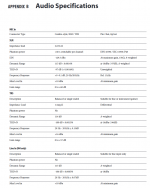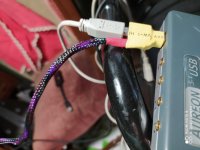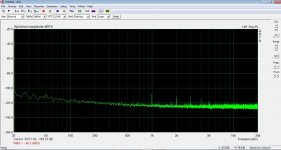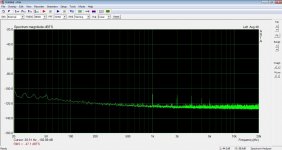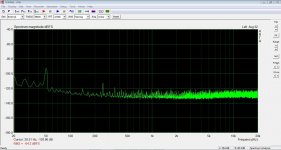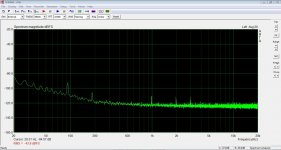I haven't got one (no stock), but there are some measurements here MOTU M4 Loopback Measurements | Audio Science Review (ASR) Forum
Not sure if -140db meets your needs, I've seen better posted, but generally it was PCI cards, or very expensive interfaces.
Hi ! very impressive figures ... thank you a lot. Yes of course that noise is more than low enough
I wonder if the two channel M2 will have similar performance. 2 channels can be enough. Even one actually. No PCI here ... i want to use a laptop.
money is an object. If only expensive solutions work i will pass. For now at least. When i will be retired i will dedicate much more time to this beautiful hobby.I was shown a most impressive USB interface here on diyaudio a while back, but I don't remember what it was, just that it was VERY good, and VERY expensive!
edit: I remembered saying "I stand corrected" so search found it Got Focusrite Scarlett 2i2 (2nd gen) for measurements. What's next? It had to be an RME
Tony.
Great brand RME indeed. Thanks again

Gino, here the noise is ultra low:
ADC AK5572 v1.2 available – nihtila.com
Hi ! thank you very much Very interesting device indeed.
i am studying it.

The M2 is not as good. The best performance with the M4 is with the two rear inputs.
See attached, and take note of the M4 only bit. The other advantage of the M4 is the fixed gain on said two inputs. Makes things MUCH easier for repeatable measurements. You can set the levels digitally, whereas with the front inputs you have variable gain (via the gain knobs) so getting the exact same setting across measurements can be difficult (had that problem with my focusrite 2i2). This is from the combined manual for the M2/M4.
Tony.
See attached, and take note of the M4 only bit. The other advantage of the M4 is the fixed gain on said two inputs. Makes things MUCH easier for repeatable measurements. You can set the levels digitally, whereas with the front inputs you have variable gain (via the gain knobs) so getting the exact same setting across measurements can be difficult (had that problem with my focusrite 2i2). This is from the combined manual for the M2/M4.
Tony.
Attachments
Last edited:
The M2 is not as good. The best performance with the M4 is with the two rear inputs.
See attached, and take note of the M4 only bit. The other advantage of the M4 is the fixed gain on said two inputs. Makes things MUCH easier for repeatable measurements. You can set the levels digitally, whereas with the front inputs you have variable gain (via the gain knobs) so getting the exact same setting across measurements can be difficult (had that problem with my focusrite 2i2). This is from the combined manual for the M2/M4.
Tony.
Hi ! thanks a lot for the helpful advice. The idea of devices working with just 5V is surprising to me ... how can they even function ? i know this is completely irrationale but the very TOTL units have all at least external power supply and they do not use usb voltage from pc. I am waiting for an external power supply to test with my current low quality sound card.
They may be using step up converters. My focusrite 2i2 has a stepup converter to give 48V phantom power (which is very clean). It is an early 1st gen so the opamps run single rail 5V. But the performance was quite good. It's currently partially dead (looks like the ADC/DAC chip is blown. all of the analogue circutry is still working fine, I've been poking around in it a lot troubleshooting what the problem is.
If you use a step up converter you can then use voltage regs to get very clean power. The current is the limiting factor though, so it needs to be all low current unless you use a separate power supply.
Using an external power supply would actually simplify the design, and make it cheaper. The units which run off the 5V USB, do so to make them completely portable. You can run them off a laptop running off battery with no external power supply, and because they have 48V phantom power as well your mics are powered as well. Basically complete fredom from the power grid
Have a look at the Clarett 2 pre Clarett 2Pre USB | Focusrite it has a 12V input but will also work off bus power IF you have a 15W usbc type port on your laptop. It obviously needs more current than standard USB can provide, so has a plug pack for that situation, but also lets you go completely portable if you have a port that can deliver enough current.
Tony.
If you use a step up converter you can then use voltage regs to get very clean power. The current is the limiting factor though, so it needs to be all low current unless you use a separate power supply.
Using an external power supply would actually simplify the design, and make it cheaper. The units which run off the 5V USB, do so to make them completely portable. You can run them off a laptop running off battery with no external power supply, and because they have 48V phantom power as well your mics are powered as well. Basically complete fredom from the power grid
Have a look at the Clarett 2 pre Clarett 2Pre USB | Focusrite it has a 12V input but will also work off bus power IF you have a 15W usbc type port on your laptop. It obviously needs more current than standard USB can provide, so has a plug pack for that situation, but also lets you go completely portable if you have a port that can deliver enough current.
Tony.
Last edited:
I believe only in objective data. Info about "Low noise mic preamp" may be possible useful for you if you need to use a mic (or a gitar?). If not then this info might not be helpful. If they don't show objective data then they don't have something very good to show.Hi i have found a video mentioning the very low noise of the mic preamp
But with a dedicate signal preamp also the line in can be used i guess
Behringer UMC202HD review (with noise measurement) - YouTube
Last edited:
They may be using step up converters. My focusrite 2i2 has a stepup converter to give 48V phantom power (which is very clean). It is an early 1st gen so the opamps run single rail 5V. But the performance was quite good. It's currently partially dead (looks like the ADC/DAC chip is blown. all of the analogue circutry is still working fine, I've been poking around in it a lot troubleshooting what the problem is.
If you use a step up converter you can then use voltage regs to get very clean power. The current is the limiting factor though, so it needs to be all low current unless you use a separate power supply.
Using an external power supply would actually simplify the design, and make it cheaper. The units which run off the 5V USB, do so to make them completely portable. You can run them off a laptop running off battery with no external power supply, and because they have 48V phantom power as well your mics are powered as well. Basically complete fredom from the power grid
Thanks a lot for the helpful explanation. With the usb injection cable
If there will be no differences with any power solution ... well it will be very important as well. But i have to see to believe
It will take some weeks to receive that bloody usb injection cable.
I have also bought some step down converters that can take a wide range of DC voltages at the input (try a SLA battery will be much easier) and have a usb socket at the output to feed the card.
I have clearly no clue of their actual performances and i am afraid that they will not be phenomenal ... but as i said i would like to see the impact of very different power supplies on the same sound card. If there will be any i will keep the better power supply and upgrade the sound card sure that the power supply does not hold it back. But i really like those noise graphs ... i like measurements in general because they are true ... they do not lie. Difficult is to look for the things that really matter of course and be able to read the results. I will be reading a lot on dual power supplies projects as a start. I was even shocked to see some even not cheap lab power supplies not performing impeccably ... what ?
they should be almost noiseless ... speaking at least of linear ones.
I already love it. Very nice and with great specs indeed. Nice.Have a look at the Clarett 2 pre Clarett 2Pre USB | Focusrite it has a 12V input but will also work off bus power IF you have a 15W usbc type port on your laptop. It obviously needs more current than standard USB can provide, so has a plug pack for that situation, but also lets you go completely portable if you have a port that can deliver enough current.
Tony.
Thanks for the suggestion.
Last edited:
I believe only in objective data. Info about "Low noise mic preamp" may be possible useful for you if you need to use a mic (or a gitar?). If not then this info might not be helpful. If they don't show objective data then they don't have something very good to show.
Hi ! yes i still go on making the same mistake ... i read
This will imply a big electrolytic cap at the input ? i guess it would be better a preamp with a high input impedance and use a plastic cap instead ?the standard mic preamp input impedance is about 10 times higher, typically ranging between 1.5 and 2kΩ
Usually these measurements are done shorting the mic inputs on the card.
I will run some tests using different 5VDC power supply on my cheap card. If there will be no differences in performance that would be an important conclusion for me. If there will be differences i will select the power supply solution that provide the lower noise floor. Just that. Thanks again.
It doesn't really matter.This will imply a big electrolytic cap at the input ? i guess it would be better a preamp with a high input impedance and use a plastic cap instead ?
It doesn't really matter
Hi ! finally a good news
I do not like electrolytics on the signal path ... even if some manufacturers use non polar ones bypassed by small plastic caps. I read a paper from Millennia, they use this solution in their mic preamps with good effect i understand.
Hi ! i got the power injection cable. No differences at all with different +5VDC power supply solutions 

Therefore is not the power supply responsible for the card noise floor ... it is something inside the card itself ... i see 4 screws
Therefore is not the power supply responsible for the card noise floor ... it is something inside the card itself ... i see 4 screws
Attachments
Last edited:
Hi i checked better with the card powered via usb cable by the laptop
From the attached pic i see the same noise floor more or less. So to me the noise floor is very card dependent and not influenced by the power supply.
If i want the -140dB i have really to change card ... and it is perfectly fine because this is a very cheap sound card. No surprise.
In the other post the first two graph have been obtained
1) 12V linear power supply and a dc-dc converter to provide 5V
2) 5V linear power supply coming with the usb injection cable
From the attached pic i see the same noise floor more or less. So to me the noise floor is very card dependent and not influenced by the power supply.
If i want the -140dB i have really to change card ... and it is perfectly fine because this is a very cheap sound card. No surprise.
In the other post the first two graph have been obtained
1) 12V linear power supply and a dc-dc converter to provide 5V
2) 5V linear power supply coming with the usb injection cable
Attachments
First two are really very similar, but the third one definitely looks much noisier.
for me the last one looks less noisy
Maybe something changed except powersupply?
Hi ! i notice now that i have not used the same dB range on the left ... so some graphs look noiser than the other ... but not enough for me to say that using an external power supply improves things significantly.
Maybe there is another dc-dc conversion inside the card ? and that sets the overall noise performance.
anyway there is a RMS value for noise on the graph (bottom left). Very similar in all cases.
The limits are clearly inside the card
Last edited:
Maybe I was wrong, the last one actually less noisy but has to much "grass". It doesn't help for measurements. So easier to use first two. The last wants some clean.for me the last one looks less noisy
Hi no inputs open
I have a question off topic
Is noise above 20 kHz really a problem for an audio device? Because sometimes there is high frequency noise
I start loving dc-dc voltage converters a lot they are cute
As i need a dual supply +/-24V i have seen converters providing that with switching at 150 khz i wonder if they could be a valid option
I say this because smps are more and more common on pro audio equipment
Thanks a lot to All again
I have a question off topic
Is noise above 20 kHz really a problem for an audio device? Because sometimes there is high frequency noise
I start loving dc-dc voltage converters a lot they are cute
As i need a dual supply +/-24V i have seen converters providing that with switching at 150 khz i wonder if they could be a valid option
I say this because smps are more and more common on pro audio equipment
Thanks a lot to All again
- Status
- This old topic is closed. If you want to reopen this topic, contact a moderator using the "Report Post" button.
- Home
- Design & Build
- Equipment & Tools
- USB sound card for noise measurements
